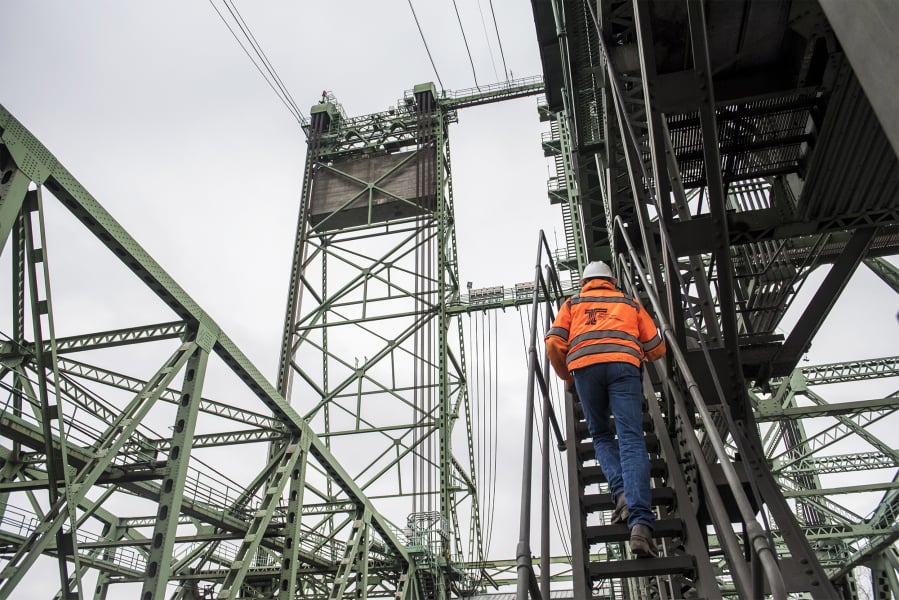One could think about the Interstate 5 Bridge as being sort of alive.
An Oregon Department of Transportation crew of 10 works inside of the structure’s bridge house, an area not immediately noticeable to any of the estimated 131,000 average daily passers-by going northbound and southbound in the month of December.
They man the fort, so to speak, for 12-hour shifts at a time, required to answer the call of a passing vessel within 30 seconds. If the ship needs extra clearance to get beneath the 102-year-old green giant, the crew member needs to raise the bridge’s lift span.
And Marc Gross, 49, who lives in Battle Ground, has been the bridge supervisor for the last 18 years, trying to keep things running smoothly.
“That’s the Coast Guard rule; we have to have somebody on board here to answer a radio call within 30 seconds,” Gross said. “This is a navigable waterway for the Coast Guard; and as a safety corridor, they want to have somebody here to basically answer the radio and make decisions about what needs to happen with this movable structure.”
Closure hours
The crew must lift the I-5 Bridge when a vessel comes through and needs the clearance with the exception of closure periods from 6:30 to 9 a.m. and 2:30 to 6 p.m. Monday through Friday, except holidays. Both the northbound and southbound spans will see midmorning lifts lasting 15 minutes around 10 a.m. Jan. 28 and Jan. 31. The lifts are happening ahead of the September 2020 trunnion repair, which will cause a closure of the northbound span for two weeks. See information including a bridge traffic cam here.
Costs
The Interstate 5 Bridge operations do not generate revenue. The crew of 10, including four full-timers, costs $1 million split between Oregon and Washington. Routine subcontracted repairs and maintenance are budgeted for $1.2 million a year.
Though he’s worked with the bridge for the last 18 years, he has been with ODOT for nearly 25 years, moving his way up the ranks, following some time operating equipment and helping build roads while in the Army at Fort Leonard Wood, Mo., and later the Oregon National Guard.
A maintenance worker at heart, his orange sweater was smudged with the evidence of manual labor, although he said he spends about half his time in Oregon, participating in meetings and sorting through issues and the typical bureaucratic hurdles associated with operating such a structure.
And with the Interstate 5 Bridge, there’s certainly a lot to talk about. It’s been a sticking point with the Portland and Vancouver communities and local politics for a number of years as traffic congestion gets worse.
“When I moved here, it was 1994, and I-205 was a very, very smooth, easy commute. And I watched that change drastically,” he said solemnly. “There’s traffic congestion. It’s going to weigh heavy on people’s minds, on how they get places.”
The I-5 Bridge doesn’t have big shoulders, either; a single crash heavily impacts vehicles being able to pass.
But he knows with a bridge replacement, the old crew would be lost and placed into other roles; some of them have been working there for decades.
“These guys only have this job because it’s a movable bridge … they’re not maintenance cost-effective, and generally movable bridges are an impassable structure. So their look is to design a structure that is passable on a regular basis, very much like the Glenn Jackson Bridge,” he said. The bridge lifts 200 times in a year, he said. That includes commercial ships, grain ships and pleasure craft. Springtime is the busiest for lifts when the Columbia River runs high, lessening the space between the bridge and the water.
Gross says technology advancements have already reduced the crew, who are especially passionate about operating the bridge. The last major upgrade in technology happened in 2005, he said.
“There used to be 24 (crew members) when it was a three-man (at a time) operation before cameras and technology took over,” he said. “Then, once camera technology, sensors and warning devices (were installed) in the 1980s, there was a transformation, and they reduced the crew down slowly since I’ve been running the crew here.”
One crew member retired last year, he said.
“It’s probably bare minimum. That’s pretty much what it takes to keep maintenance up and bridge operations,” he said.
The bridge crew costs a bit more than $1 million a year, split equally with the state of Washington, according to agency spokesman Don Hamilton. Routine subcontracted repairs and maintenance are budgeted for another $1.2 million annually.
Gross has a base salary of $59,119 and earned $22,470 in overtime pay in 2017, according to a database of Oregon government employee salaries maintained by the Oregonian.
“Down to the nuts and bolts is what we have to get accomplished,” Gross said. “(Interstate 5 Bridge) is always in the news. It’s on lots of people’s pictures in offices and banks. I see it in the newspapers … it’s iconic. I know it’s very iconic,” Gross said. “With the guys, the crew, we just try to operate and do things, or try to, quietly, and keep it going the best I can without too much commotion and interruption to people.”
He has only five more years to go until his 30 years with ODOT, when he’ll be eligible for retirement. After that, eventually the Columbia River will see a new bridge that doesn’t move and doesn’t require a crew for him to oversee.
“This bridge will get handed off to another supervisor at some point in time who will probably take it to its final stages,” he said. “I would imagine in 20 or 30 years, there should be something here to replace this to be more accommodating to vehicle traffic and then marine traffic.”




